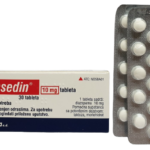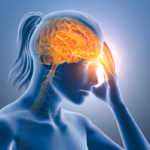Does Diazepam (Valium) Help With Migraines?

A migraine is a common neurological disease that causes a variety of symptoms, most notably a throbbing, pulsing headache on one side of your head. Your migraine will likely get worse with physical activity, lights, sounds or smells. It may last at least four hours or even days. About 12% of Americans have this genetic disorder. Research shows that it’s the sixth most disabling disease in the world. Migraine headaches are a common cause of disability in the United States, affecting approximately 60 million American adults, or 17.1% of women and 5.6% of men
There are over 150 types of headaches, divided into two categories: primary headaches and secondary headaches. A migraine is a primary headache, meaning that it isn’t caused by a different medical condition. Primary headache disorders are clinical diagnoses, meaning there’s no blood test or imaging study to diagnose it. A secondary headache is a symptom of another health issue.
What is diazepam?
Diazepam oral tablet is a controlled substance drug that’s available as the brand-name drug Valium. It’s also available as a generic drug. Generic drugs usually cost less. In some cases, they may not be available in every strength or form as the brand-name version.
Diazepam is also available as an oral solution, an intravenous injection, a liquid nasal spray, and a rectal gel.
How it works
Diazepam belongs to a class of drugs called benzodiazepines. A class of drugs refers to medications that work similarly. They have a similar chemical structure and are often used to treat similar conditions.
Diazepam increases the activity of gamma-aminobutyric acid (GABA), a special chemical that can send signals throughout your nervous system. If you don’t have enough GABA, your body may be in an excited state and cause you to have anxiety, get muscle spasms, or have seizures. When you take this drug, you’ll have more GABA in your body. This will help decrease your anxiety, muscle spasms, and seizures.
Why it’s used
Diazepam oral tablet is used to treat the following conditions:
- anxiety
- symptoms caused by alcohol withdrawal, such as agitation or tremors
- add-on treatment for skeletal muscle spasms
- add-on treatment for certain types of seizure
It may be used as part of a combination therapy. That means you need to take it with other drugs.
How should I take diazepam?
Take diazepam exactly as it was prescribed for you. Follow the directions on your prescription label and read all medication guides. Your doctor may occasionally change your dose. Never use this medicine in larger amounts, or for longer than prescribed. Tell your doctor if you feel an increased urge to use more of diazepam.
Diazepam should be used for only a short time. Do not take this medicine for longer than 4 months without your doctor’s advice.
Does diazepam (Valium) help with migraines?
Yes, diazepam can help relieve migraine symptoms because of its ability to depress the nervous system which can provide temporary pain relief for migraines. Many neurologists use diazepam and similar drugs for acute attacks. Preventive medicines vary, and the choice of the best agent depends often on other conditions the person has. Everyone with migraine should try to find and avoid triggers. This includes eating on a reasonable schedule and good sleep hygiene.
What are the possible side effects of using diazepam (Valium) for migraines?
Get emergency medical help if you have signs of an allergic reaction to diazepam: hives; difficult breathing; swelling of your face, lips, tongue, or throat.
Diazepam can slow or stop your breathing, especially if you have recently used an opioid medication, alcohol, or other drugs that can slow your breathing. A person caring for you should seek emergency medical attention if you have weak or shallow breathing, if you are hard to wake up, or if you stop breathing.
Call your doctor at once if you have:
• severe drowsiness or dizziness;
• unusual changes in mood or behavior;
• new or worsening symptoms of depression or anxiety;
• thoughts of suicide or hurting yourself;
• confusion, hallucinations, sleep problems; or
• new or worsening seizures.
The sedative effects of diazepam may last longer in older adults. Accidental falls are common in elderly patients who take benzodiazepines. Use caution to avoid falling or accidental injury while you are taking this medicine.
Common diazepam side effects may include:
• drowsiness;
• feeling tired;
• muscle weakness; or
• problems with balance or muscle movement.
This is not a complete list of side effects and others may occur. Call your doctor for medical advice about side effects. You may report side effects to FDA at 1-800-FDA-1088.
You may also find useful information on : How Fast Does Gen Payne Work For Migrane and Headaches?





